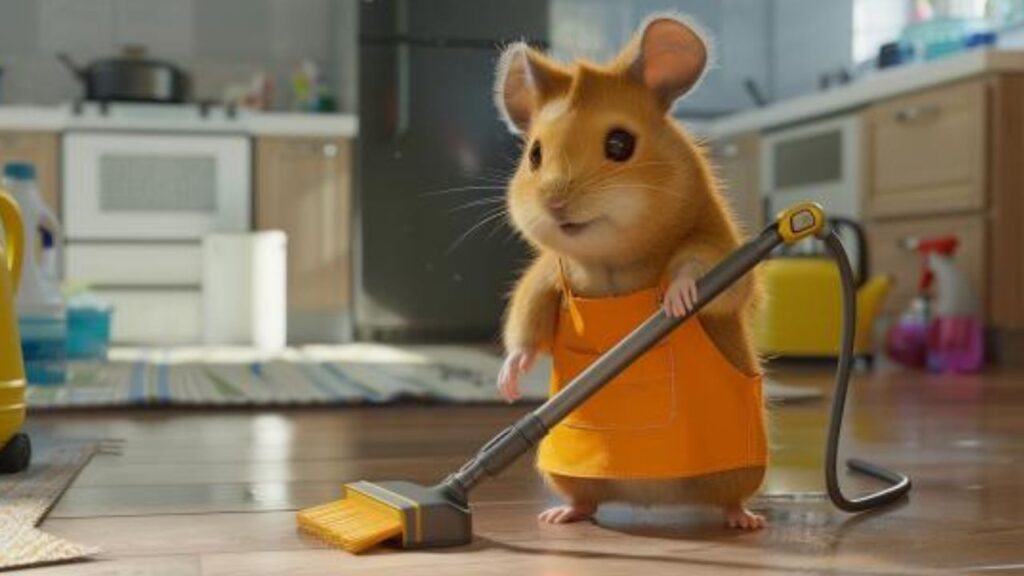Hello, fellow Hamster Whisperers! It’s Hannah Hammie here, ready to dive into the spinning world of hamster exercise wheels. Today, we’re getting into the nitty-gritty of why these wheels aren’t just fun and games; they’re an essential part of your furry friend’s well-being. Let’s roll into the details!
Why Exercise is Crucial for Hamsters
In the wild, hamsters travel several miles each night in search of food. This instinctual need for movement doesn’t vanish in captivity. Exercise is crucial for our little friends, not just for their physical health, preventing obesity and related issues, but for their mental well-being too. A hamster without a way to burn off energy can become stressed and develop unwanted behaviors. This is where exercise wheels come into play, offering an excellent outlet for their boundless energy.
The Role of Wheels in Hamster Health
An exercise wheel isn’t just a luxury; it’s a necessity for maintaining your hamster’s health. Regular use of a wheel helps in several ways. Firstly, it aids in keeping their weight in check. Obesity in hamsters is a serious concern that can lead to diabetes and heart disease. Secondly, wheel activities support cardiovascular health, keeping your hamster’s heart strong and healthy. Lastly, it’s a fantastic way for them to stave off boredom, providing mental stimulation that mimics their natural foraging behaviors.
Understanding Your Hamster’s Needs
Choosing the right exercise wheel involves understanding your hamster’s specific needs. The size of your hamster plays a significant role in selecting the appropriate wheel size. A wheel too small can cause back problems, while a wheel too large can be intimidating and remain unused. The type of wheel (silent, saucer, or traditional) also depends on your hamster’s activity level and preference. Observing your hamster’s behavior can give you clues about the best fit for their personality and physical requirements.
In the world of hamster care, the right exercise wheel is not just about providing entertainment; it’s about ensuring a happy, healthy life for your tiny companion. Stay tuned as we dive deeper into the types of wheels available, how to choose the best one, and tips for wheel training. Remember, a well-exercised hamster is a happy hamster!
Types of Hamster Wheels

When it comes to keeping our furry friends both happy and healthy, selecting the right exercise wheel is paramount. Let’s explore the different types of wheels available on the market. Each has its unique features and benefits, tailored to suit different needs and preferences.
Silent Spinners: The Quiet Choice
Silent spinners are a favorite among hamster owners who value peace and quiet. These wheels are designed to minimize noise, featuring a smooth, seamless spinning mechanism that barely whispers, even during a hamster’s most active nocturnal hours. They typically come with a solid running surface to protect tiny feet from getting caught, and their sturdy, weighted bases can either stand alone or attach directly to cage bars. Perfect for keeping in a bedroom, silent spinners ensure your hamster can run to their heart’s content without disturbing your sleep.
Saucer Wheels: A Unique Alternative
Saucer wheels offer a novel spin on the traditional exercise wheel. Instead of a wheel, they consist of a slightly concave, spinning saucer where hamsters can run. This design allows for a more natural running posture, reducing the risk of back problems associated with smaller, traditional wheels. Saucers also take up less vertical space, making them an excellent choice for cages with limited height. However, they do require a bit more horizontal room to spin freely. Their unique shape and operation can be highly entertaining for both hamsters and their human companions, adding a fun dynamic to exercise time.
Traditional Wheels: The Classic Option
Traditional wheels are the most commonly recognized form of hamster exercise equipment. They come in a variety of sizes, materials, and colors, making it easy to find one that fits your hamster’s needs and your aesthetic preferences. These wheels feature a classic, circular design with either barred or solid running surfaces. While models with bars can pose a risk for smaller hamsters’ feet, many newer traditional wheels offer solid surfaces to mitigate this issue. They can be free-standing or attachable to the cage, providing flexibility in setup. Despite their simplicity, traditional wheels are highly effective at keeping hamsters engaged and active.
Each type of wheel has its advantages, depending on your and your hamster’s preferences. Whether you prioritize silence, a unique design, or the tried and true, there’s a wheel out there that’s the perfect fit for your furry friend. Remember, the key to a happy hamster is not just any wheel, but the right wheel.
Features to Consider

Selecting the perfect exercise wheel for your hamster involves more than just picking the first one you see on the shelf. To ensure your furry friend’s happiness and safety, there are several key features to consider. Let’s delve into the aspects of size and safety, the debate between plastic and metal, and the importance of ease of cleaning.
Size and Safety: Ensuring a Perfect Fit
The size of the wheel is crucial. A wheel that’s too small can cause your hamster to arch its back unnaturally, potentially leading to spinal injuries over time. Conversely, a wheel that’s too big may be difficult for them to move, discouraging exercise. As a general guide, the wheel should be large enough so that your hamster can run with a straight back. For Syrian hamsters, this typically means a wheel with a diameter of at least 8 inches, while smaller breeds like dwarfs can use wheels around 6.5 inches in diameter.
Safety extends beyond size. The wheel’s design should prevent injuries, with solid running surfaces preferred over bars to protect tiny feet from getting caught. Additionally, the wheel should be stable and securely attached to the cage or stand firmly on the ground to prevent tipping over during use.
Material Matters: Plastic vs. Metal
The debate between plastic and metal wheels is ongoing among hamster enthusiasts. Each material has its pros and cons. Plastic wheels are lightweight, come in various colors, and are often less expensive. They can be easier for hamsters to run on and are generally quieter. However, they may not be as durable as metal wheels and can be chewed by particularly gnawy hamsters.
Metal wheels, on the other hand, offer durability and longevity. They’re more resistant to chewing and can provide a more stable running surface. However, metal wheels can be noisier and, if not properly coated, may pose a risk of injury due to the colder surface and potential for rust. Choosing between plastic and metal often comes down to personal preference and considering your hamster’s behavior and needs.
Ease of Cleaning: Maintenance Musts
Hygiene is paramount in keeping your hamster healthy, making the ease of cleaning an important factor in wheel selection. Wheels should be easy to disassemble for thorough cleaning, as hamsters often urinate and defecate while running. Plastic wheels are generally easier to clean, as they can be wiped down or soaked without rusting. If you opt for a metal wheel, ensure it has a protective coating to prevent rust and facilitate cleaning.
Regular maintenance not only extends the life of the wheel but also ensures a safe and healthy environment for your hamster. Choosing a wheel that can be easily integrated into your cleaning routine will make life easier for both you and your furry friend.
By carefully considering the size and safety, material, and ease of cleaning, you can select an exercise wheel that will provide your hamster with endless hours of safe, healthy fun.
Training Tactics: Wheel Training 101

Introducing a new exercise wheel to your hamster’s environment is an exciting venture, but it requires patience and understanding. Here’s my personal guide to wheel training, ensuring a smooth transition and fostering a love for their new toy. From the initial introduction to regular use and health monitoring, let’s roll through the steps to success.
Introducing Your Hamster to the Wheel
The first step is making the wheel an inviting part of your hamster’s home. Place the wheel in their cage in a spot that’s easily accessible, but not in the way of their usual sleeping or eating areas. Initially, your hamster may be wary or uninterested. Patience is key. You can encourage exploration by placing treats on or near the wheel. Some hamsters will hop on out of curiosity, while others may need a few days to adjust to the new object in their space. Remember, never force your hamster onto the wheel, as this can cause stress and fear, making the wheel a negative part of their environment.
Encouraging Regular Use
Once your hamster has discovered the wheel, encouraging regular use is essential for their physical health. If your hamster seems hesitant to use the wheel regularly, there are a few tactics you can try. First, ensure the wheel is the correct size and type for your hamster, as discomfort can deter use. You can also try changing the wheel’s location within the cage to spark renewed interest. Incorporating wheel time into their daily routine, especially during their active hours at dusk or dawn, can also promote regular use. Some gentle encouragement, such as leading them to the wheel with treats or gentle nudging, can also be beneficial.
Monitoring Wheel Activity for Health
Observing your hamster’s wheel activity offers valuable insights into their health and well-being. A sudden decrease in wheel use can be an early sign of health issues, such as arthritis, injury, or illness. Conversely, excessive wheel use can indicate stress or a lack of environmental stimulation. Monitor their activity patterns and adjust their environment as needed to encourage healthy wheel use. This could mean providing more enrichment activities outside the wheel or consulting a veterinarian if you notice any signs of health problems.
Remember, every hamster is an individual with unique preferences and behaviors. What works for one may not work for another. The key is to observe, adjust, and provide a supportive and enriching environment that encourages your hamster to embrace their wheel as a fun and beneficial part of their daily routine.
Common Mistakes to Avoid

Embarking on the journey of hamster ownership is filled with learning curves and discoveries. When it comes to providing the best care for your furry friend, especially regarding their exercise wheel, there are a few common pitfalls you’ll want to avoid. Here’s a rundown of mistakes that can easily be sidestepped with a bit of knowledge and attentiveness.
Choosing the Wrong Size
One of the most frequent errors in selecting a hamster wheel is opting for the wrong size. A wheel that’s too small forces your hamster to run with an arched back, which can lead to long-term spinal issues. On the flip side, a wheel that’s too large may be intimidating or too difficult for your hamster to operate, leading to frustration and disuse. For Syrian hamsters, a wheel with a diameter of at least 8 inches is recommended, while dwarf hamsters typically require a wheel of about 6.5 inches in diameter. Ensuring the wheel is the appropriate size for your specific breed will promote a healthy and active lifestyle.
Neglecting Wheel Maintenance
Another oversight is the neglect of regular wheel maintenance. Just like any other piece of equipment, exercise wheels need to be kept clean and in good working order. A wheel that becomes noisy, wobbly, or difficult to spin due to lack of care can deter your hamster from using it. Furthermore, wheels can accumulate bedding, food, and waste, which if not cleaned regularly, can lead to unsanitary conditions and potentially harm your hamster’s health. Incorporating wheel checks and cleaning into your routine ensures a safe and inviting exercise environment.
Ignoring Your Hamster’s Preferences
Finally, a mistake often made by well-meaning owners is ignoring their hamster’s individual preferences. Just like humans, hamsters have their own likes and dislikes. Some may prefer a silent spinner for its quiet operation, while others might enjoy the open design of a saucer wheel. If your hamster isn’t using the wheel you’ve provided, it might not be the right fit for them. Observing your hamster’s behavior and trying different types of wheels can help you find the perfect match. Remember, the goal is to encourage activity and enrichment, so being flexible and responsive to your hamster’s needs is key.
Avoiding these common mistakes can greatly enhance your hamster’s quality of life. By choosing the right size wheel, maintaining it properly, and paying attention to your hamster’s preferences, you’re setting the stage for a happy, healthy, and active companion.
Conclusion: The Path to Wheel Success

As we reach the end of our journey through the world of hamster exercise wheels, it’s clear that the path to finding the perfect wheel is paved with careful consideration, patience, and celebration of your hamster’s unique personality and needs. Let’s take a moment to recap the key points, underscore the importance of patience, and highlight how celebrating your hamster’s milestones can be deeply rewarding.
Recap: Matching Wheel to Hamster
Choosing the right exercise wheel for your hamster is a decision that significantly impacts their health and happiness. Remember, the ideal wheel size ensures your hamster can run comfortably without arching its back, which is crucial for preventing injuries and promoting overall well-being. Furthermore, the material of the wheel—be it plastic or metal—should suit your hamster’s behavior and your cleaning preferences. Additionally, considering the wheel’s design, whether a silent spinner, saucer, or traditional wheel, can greatly affect your hamster’s engagement and satisfaction. Each hamster is unique, and their wheel should reflect their individual needs and preferences.
The Importance of Patience in Training
Introducing a new wheel to your hamster and encouraging its use requires patience. Some hamsters may leap onto their new wheel with gusto, while others need time to adjust to the idea. Patience in training not only fosters a stress-free environment for your hamster but also strengthens the bond between you. Observing and responding to your hamster’s pace without rushing or forcing them ensures a positive experience and lays the foundation for regular, enthusiastic wheel use.
Encouragement: Celebrating Your Hamster’s Milestones
Acknowledging and celebrating each milestone, no matter how small, is a joyful aspect of hamster ownership. Whether it’s the first time your hamster climbs onto the wheel, the first full spin, or the establishment of a regular running routine, these moments are worth celebrating. Encouragement can take many forms, from extra treats to gentle praise and even simply sharing their achievements with fellow hamster enthusiasts. These celebrations not only reinforce positive behavior but also deepen the connection between you and your furry friend.
The journey to wheel success is a rewarding experience that enhances your hamster’s quality of life and enriches your relationship with them. By carefully selecting the right wheel, practicing patience during training, and celebrating each of your hamster’s achievements, you’re not just providing them with a piece of exercise equipment; you’re giving them the gift of health, happiness, and love.




